UPDATE 2:
I've tried several ways including adding layers or creating custom image filters that use the background image as input image but none of these solutions got the desired result. The main problem was always the view hierarchy.
I may have found a solution by using a generated image of the views or the actual background image as the content background of the childView once the childChildView is being created but before being displayed. I've changed your example code a bit to add a scroll view and background image in the parentView. See if this works for you / is your desired result:
import UIKit
import PlaygroundSupport
class MyViewController : UIViewController {
override func loadView() {
let parentView = UIView()
parentView.backgroundColor = .purple
let imageName = "image.jpg"
let image = UIImage(named: imageName)
let imageWidth = Int((image?.size.width)!)
let imageheight = Int((image?.size.height)!)
let imageView = UIImageView(image: image!)
imageView.frame = CGRect(x: 50, y: 50, width: imageWidth , height: imageheight)
parentView.addSubview(imageView)
// Child view as UIScrollView
let childView = UIScrollView(frame: CGRect(x: 55, y: 55, width: imageWidth - 10, height: imageheight - 10 ))
childView.contentSize = CGSize(width: imageWidth - 10, height: 5000)
childView.layer.borderColor = UIColor.orange.cgColor
childView.flashScrollIndicators()
childView.layer.borderWidth = 10
parentView.addSubview(childView)
// ChildChild view
let childChildView = UIView(frame: CGRect(x: 15, y: 100, width: 85, height: imageheight - 180))
childChildView.layer.compositingFilter = "overlayBlendMode"
childChildView.backgroundColor = .white
//Creating a static image of the background views BEFORE adding the childChildView.
let format = UIGraphicsImageRendererFormat()
format.scale = 1
format.preferredRange = .standard ///color profile
///Change the imageView to the parentView size of the app. Not available if not set in the playground.
let renderer = UIGraphicsImageRenderer(size: imageView.bounds.size, format: format)
let imageBG = renderer.image { context in
///This draws all subviews of the parentView one after the other.
///Because the background image is not a parent of our current view, otherwise childView.drawHierachy would have been enough
for subview in parentView.subviews {
///Skip specific views or view classes you don't want to be added to the image. or if you only need the parentView itself rendered remove the for in loop.
subview.drawHierarchy(in: imageView.bounds, afterScreenUpdates: true)
}
}
//Adding the static background image. This could simply also be the actual image: UIImage if no other views are supposed to be used.
childView.layer.contents = imageBG.cgImage
childView.addSubview(childChildView)
self.view = parentView
}
}
// Present the view controller in the Live View window
PlaygroundPage.current.liveView = MyViewController()
It results in the following:

UPDATE:
The colors in the images are misleading, as you could assume a normal transparency effect would be the same. But the overlayBlendMode is quite different as Coconuts has pointed out. I assume the issue is that the compositingFilter only works with the view below, even if this view is transparent.
I tried finding a workaround by using a mask that cuts out a square of the size of the childchild from the childview. But this also didn't work as the mask is also applied to all subviews. The only way I got it to work is by making the childchildview a sibling of childview instead, or a direct subview of the background view. But not sure if this will be possible in the complex view hierarchy mentioned by Coconuts.
// Sibling view with adjusted x and y
let childChildView = UIView(frame: CGRect(x: 100, y: 100, width: 100, height: 50))
childChildView.backgroundColor = .white
childChildView.layer.compositingFilter = "overlayBlendMode"
parentView.addSubview(childChildView)
MISC:
To only get the visual result of the sample images, not actually using the overlayBlendMode filter as asked by Coconut.
If you only need to blend the color you could change the alpha value of the color.
// Child child view
let childChildView = UIView(frame: CGRect(x: 50, y: 50, width: 100, height: 50))
childChildView.backgroundColor = UIColor(white: 1, alpha: 0.5)
//childChildView.layer.compositingFilter = "overlayBlendMode"
childView.addSubview(childChildView)
Or try this:
// Child child view
let childChildView = UIView(frame: CGRect(x: 50, y: 50, width: 100, height: 50))
childChildView.backgroundColor = .white
childChildView.layer.opacity = 0.5
childView.addSubview(childChildView)
ADDITIONAL ATTEMPTS WHEN HAVING SEVERAL SCROLL VIEWS:
This is an attempt to solve the from Coconut added more complicated view hierarchy with multiple scroll views. The performance needs to be improved or the part that adjusts the background image of the background image layer needs to run in sync when the app is updating (redrawing) its views. At the moment it's lagging behind a bit.
import UIKit
import PlaygroundSupport
class MyViewController : UIViewController {
override func loadView() {
let parentView = UIView()
// Background image
let backgroundImageView = UIImageView(image: UIImage(named: "image.jpg")!)
backgroundImageView.frame = UIScreen.main.bounds
parentView.addSubview(backgroundImageView)
// Page view (horizontal scrollview)
let pageView = UIScrollView(frame: CGRect(x: 50, y: 50, width: 200, height: 200))
pageView.contentSize = CGSize(width: 600, height: 200)
pageView.flashScrollIndicators()
pageView.layer.borderColor = UIColor.yellow.cgColor
pageView.layer.borderWidth = 3
pageView.clipsToBounds = true
parentView.addSubview(pageView)
// Child view (vertical scrollview)
let childView = UIScrollView(frame: CGRect(x: 20, y: 20, width: 100, height: 150))
childView.contentSize = CGSize(width: 100, height: 300)
childView.layer.borderColor = UIColor.red.cgColor
childView.layer.borderWidth = 3
pageView.addSubview(childView)
// Child child view
let childChildView = UIView(frame: CGRect(x: 50, y: 50, width: 50, height: 50))
//Child child view foreground sublayer
let childChildFrontLayer = CALayer()
childChildFrontLayer.frame = childChildView.frame.offsetBy(dx: -75, dy: -50)
childChildFrontLayer.backgroundColor = UIColor.white.cgColor
childChildFrontLayer.compositingFilter = "overlayBlendMode"
//Child child view background sublayer
let childChildBackLayer = CALayer()
childChildBackLayer.contents = UIImage(named: "image.jpg")?.cgImage
var absolutFrame = parentView.convert(childChildView.frame, from: childView)
childChildBackLayer.frame = CGRect(x: -absolutFrame.minX, y: -absolutFrame.minY, width: backgroundImageView.frame.width, height: backgroundImageView.frame.height)
childChildView.layer.addSublayer(childChildBackLayer)
childChildView.layer.addSublayer(childChildFrontLayer)
childView.addSubview(childChildView)
//Checking for any scrolling. Is slightly faster then the scollview delegate methods but might cause main thread checker warning.
DispatchQueue.global(qos: .userInteractive).async {
while true {
if pageView.isDragging || pageView.isTracking || pageView.isDecelerating || childView.isDragging || childView.isTracking || childView.isDecelerating {
absolutFrame = parentView.convert(childChildView.frame, from: childView)
DispatchQueue.main.async {
childChildBackLayer.frame = CGRect(x: -absolutFrame.minX, y: -absolutFrame.minY, width: backgroundImageView.frame.width, height: backgroundImageView.frame.height)
}
}
}
}
self.view = parentView
}
}
// Present the view controller in the Live View window
PlaygroundPage.current.liveView = MyViewController()


